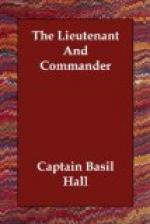Since the cool air of the temperate and comparatively slow-moving zones beyond the tropics is thus drawn towards the equator, and comes successively in contact with parallels of latitude moving faster and faster towards the east, there must be gradually imparted to it, by the increased friction, a considerable degree of the increased rotatory velocity belonging to the low latitudes it has now reached; that is to say, there will be less and less difference of velocity between the easterly motion of this temperate air and the easterly motion of the earth; and, consequently, the wind, as it approaches the equator, will appear to blow less and less directly from the eastward. But, while the earth’s rotation within the tropics is thus acting on the slower-moving air which has travelled to it from beyond the tropics, with increased friction at every successive moment, there has been no such powerful counteracting influence in operation to diminish the meridional motion impressed on the air in question; for, although in proceeding from the tropics towards the equator, the wind might, at first sight, be supposed to have its speed somewhat lessened by friction along the earth’s surface, the retardation due to this cause, if there be any at all, must be inconsiderable, compared to that which affects the motion caused by the difference in the rotatory velocity of the earth at the different parallels. It must be recollected, also, that there is a constant demand for fresh air from the north and south, to occupy the place of the heated and rarefied air which is raised up in the torrid zone; and this demand being pretty equal, the motion it produces on the air in the direction of the meridian must likewise be uniform.
If it be admitted that all the easterly character of the Trade-winds is due to the difference of velocity between the rotation of the torrid zone of the earth from west to east, and that of the air impressed only with the slower rotatory motion to the east of the temperate zone, it will follow, that, if this difference of velocities between the earth and the air in contact with it be diminished or annihilated, the easterly character of these winds will be diminished or annihilated likewise. At the same time, there is no cause in operation, that I can discover, to alter the direction of the meridional motion, as it may be called, of the Trade-winds, or that by which they are impelled directly towards the equator.
At first starting from the temperate zone, on its voyage to the equator, the cold air of that slow-moving region is impressed with a rotatory velocity of only 800 miles per hour to the eastward, but it soon comes over parts of the earth moving more than 100 miles per hour faster to the eastward than itself. The difference of velocity in the earth’s rotation between latitudes 30 deg. and 20 deg. is 74 miles an hour, while between 20 deg. and 10 deg. it is only 45 miles, and in the next ten degrees the difference in rate per hour is reduced to 15 miles.




